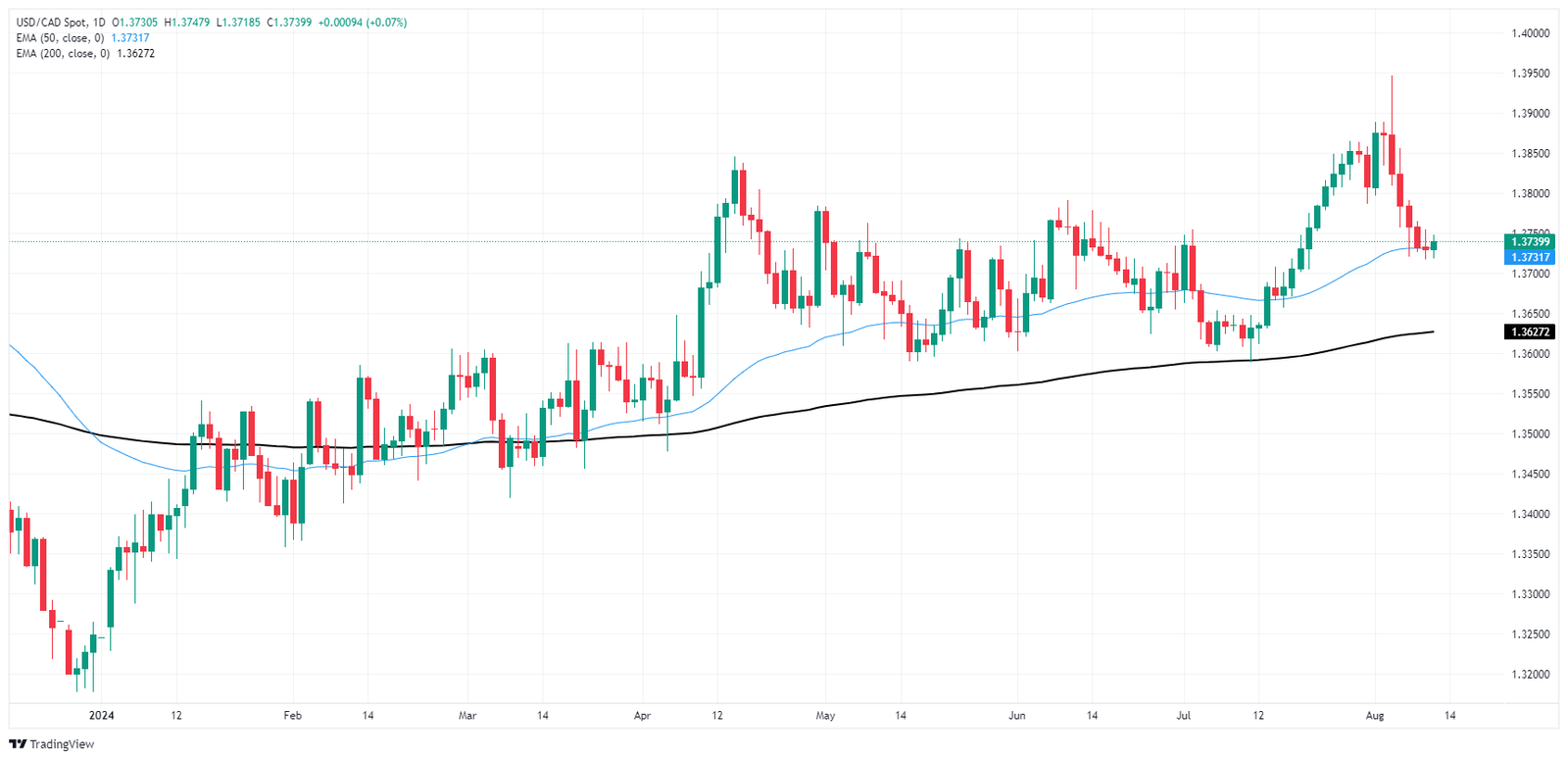- The Canadian Dollar was soft-footed to kick off Monday trading.
- Canada is drastically underrepresented on the economic calendar this week.
- US inflation data updates are the key to the week’s market sentiment.
The Canadian Dollar (CAD) struggled to find direction on Monday, easing against most of its major currency peers and middling against the Greenback on the charts. The CAD is holding steady at the top end of a swing high against the USD, but markets are huddling in the midrange as investors await the latest batch of US inflation figures due in the midweek.
Canada has a strictly low-tier showing on the economic calendar this week, leaving the Canadian Dollar at the mercy of overall market sentiment. Investors are still grappling with how the Federal Reserve’s (Fed) upcoming rate call in September will shake out, but rate markets are firmly gripping onto expectations of at least a quarter-point trim on September 18.
Daily digest market movers: Looming CPI prints leave markets hung in the midrange
- Canadian Building Permits declined again in June, printing at -13.9% MoM and adding to the previous month’s revised -12.7% contraction. Market impact is overall limited from low-tier housing data two months behind the curve, and CAD flows remain crimped.
- Fed one-year inflation expectations ticked lower on Monday, falling to 2.97% versus the previous 3.02%.
- Rate markets have eased back on bets of a double-cut in September, according to the CME’s FedWatch Tool. Rate traders now see less than 50% odds of a 50-bps cut on September 18, down from last week’s 70% odds.
- Despite the chill in bets for a double-cut, rate markets are still pricing in 100% odds of at least a 25-bps cut from the Fed in September.
- Key US inflation data in the midweek could throw a spanner in the works if price pressures bubble over again.
- US Producer Price Index (PPI) inflation due on Tuesday, US Consumer Price Index (CPI) inflation slated for Wednesday. Both metrics are expected to tick lower.
Canadian Dollar price forecast: Steady gains lead to middling ranges
The Canadian Dollar (CAD) put in a subpar performance on Monday, ticking lower against most of its major currency peers but finding thin gains against the Japanese Yen and the Swiss Franc. The CAD backslid over a quarter of a percent against the rebounding Antipodeans, and struggled to find direction against the Greenback and the European bloc, trading down within one-fifth of one percent against the Euro and the Pound Sterling.
USD/CAD price action has ground to a halt as bids grapple with the 50-day Exponential Moving Average (EMA) at 1.3730. Last week’s early Greenback rally failed to capture the 1.3950 level, giving the Canadian Dollar a chance to reclaim recently lost ground.
Technical pressures are keeping bids bolstered above the 200-day EMA at 1.3625, but bullish CAD momentum could evaporate at any time, driving USD/CAD back into the high end.
USD/CAD daily chart
Canadian Dollar FAQs
The key factors driving the Canadian Dollar (CAD) are the level of interest rates set by the Bank of Canada (BoC), the price of Oil, Canada’s largest export, the health of its economy, inflation and the Trade Balance, which is the difference between the value of Canada’s exports versus its imports. Other factors include market sentiment – whether investors are taking on more risky assets (risk-on) or seeking safe-havens (risk-off) – with risk-on being CAD-positive. As its largest trading partner, the health of the US economy is also a key factor influencing the Canadian Dollar.
The Bank of Canada (BoC) has a significant influence on the Canadian Dollar by setting the level of interest rates that banks can lend to one another. This influences the level of interest rates for everyone. The main goal of the BoC is to maintain inflation at 1-3% by adjusting interest rates up or down. Relatively higher interest rates tend to be positive for the CAD. The Bank of Canada can also use quantitative easing and tightening to influence credit conditions, with the former CAD-negative and the latter CAD-positive.
The price of Oil is a key factor impacting the value of the Canadian Dollar. Petroleum is Canada’s biggest export, so Oil price tends to have an immediate impact on the CAD value. Generally, if Oil price rises CAD also goes up, as aggregate demand for the currency increases. The opposite is the case if the price of Oil falls. Higher Oil prices also tend to result in a greater likelihood of a positive Trade Balance, which is also supportive of the CAD.
While inflation had always traditionally been thought of as a negative factor for a currency since it lowers the value of money, the opposite has actually been the case in modern times with the relaxation of cross-border capital controls. Higher inflation tends to lead central banks to put up interest rates which attracts more capital inflows from global investors seeking a lucrative place to keep their money. This increases demand for the local currency, which in Canada’s case is the Canadian Dollar.
Macroeconomic data releases gauge the health of the economy and can have an impact on the Canadian Dollar. Indicators such as GDP, Manufacturing and Services PMIs, employment, and consumer sentiment surveys can all influence the direction of the CAD. A strong economy is good for the Canadian Dollar. Not only does it attract more foreign investment but it may encourage the Bank of Canada to put up interest rates, leading to a stronger currency. If economic data is weak, however, the CAD is likely to fall.






